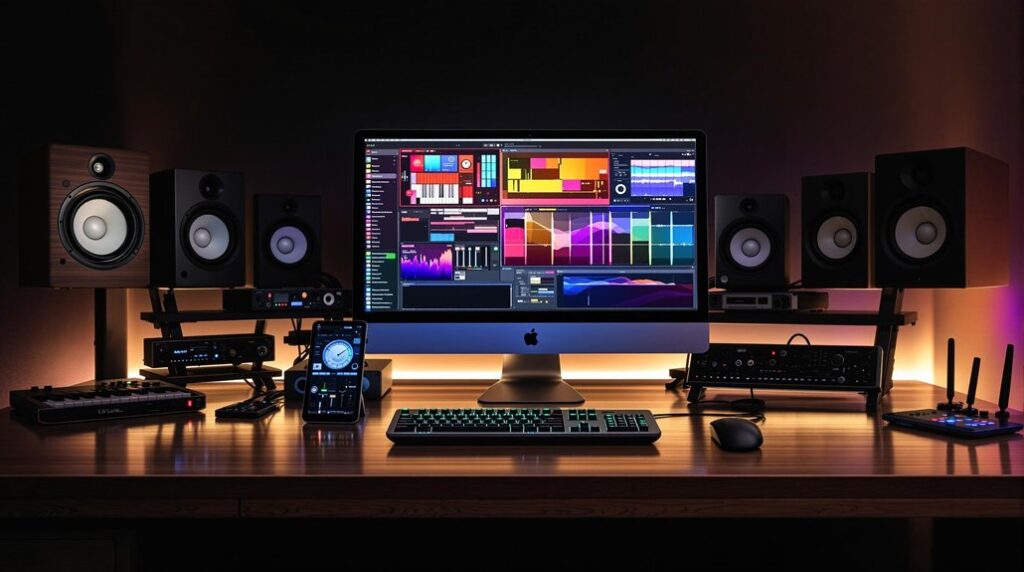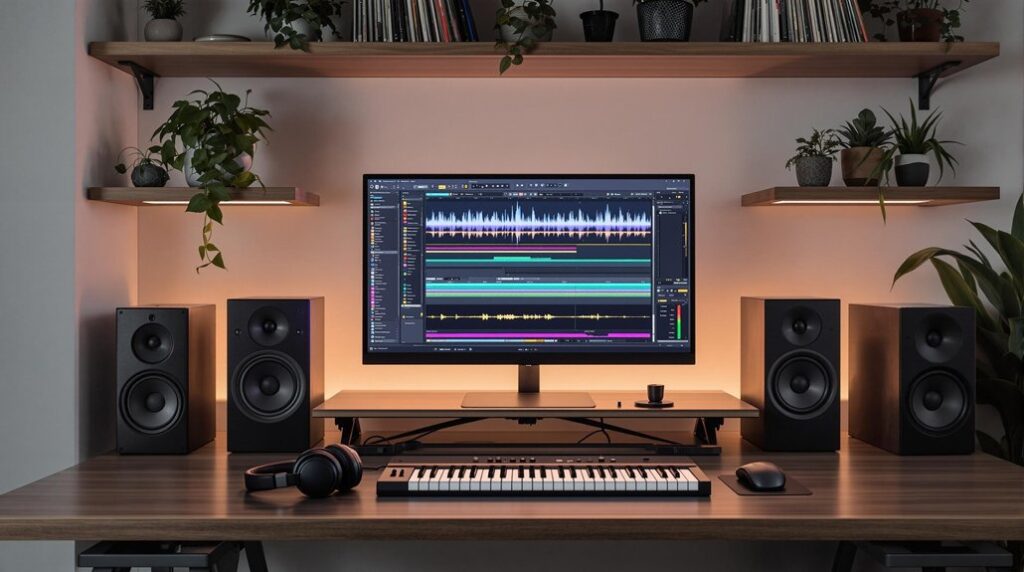To open the Piano Roll in Ableton Live, start by launching the application. Once it’s open, navigate to either Session or Arrangement View to locate your MIDI clips. You can create a MIDI track if necessary by using the shortcut Shift + Command/Control + T. Simply double-click on any MIDI clip to access the Piano Roll editor, where you can efficiently edit your notes by adding, rearranging, or deleting them using your mouse or keyboard shortcuts. This setup enhances your editing workflow, allowing for precise control over your composition. Further exploration reveals even more powerful editing techniques.
Key Takeaways
- Launch Ableton Live and navigate to either Session or Arrangement View to access your MIDI tracks.
- Create a new MIDI track using the shortcut (Shift + Command/Control + T) if necessary.
- Locate a MIDI clip and double-click it to open the piano roll editor.
- Use drag-and-drop to rearrange notes or keyboard shortcuts for efficient editing.
- Zoom in/out within the piano roll for precise adjustments to your composition.
Launch Ableton Live
To begin your music production journey in Ableton Live, first make sure that you launch the application effectively. You can do this by double-clicking the application icon or accessing it from your applications folder.
Once launched, verify that Ableton Live is fully loaded to guarantee ideal functionality during your session. Checking for any available software updates is also vital, as this enhances the features and capabilities of the application.
Familiarize yourself with the interface layout, particularly the Session View, as it greatly improves navigation and workflow efficiency. Understanding the core areas of the interface, such as Session and Arrangement Views, will ultimately boost your productivity and ease when working with MIDI clips and other elements in your music creation process.
Access MIDI Clips
After launching Ableton Live and familiarizing yourself with its interface, the next step involves accessing MIDI clips, a fundamental aspect of music production. To do this, make sure you are in either Session or Arrangement View.
Locate the desired MIDI track and double-click on a MIDI clip; this action opens the piano roll editor, where you can perform detailed note editing. Efficiently switch between different MIDI clips to streamline your workflow. Additionally, you can use the mute function to isolate tracks while editing, ensuring a clearer focus on your MIDI arrangements.
In the clip view, basic editing actions include dragging notes to rearrange them and utilizing keyboard shortcuts for enhanced productivity. By familiarizing yourself with the piano roll features, you can greatly improve your MIDI clip editing capabilities, allowing for more creative control over your compositions.
Open the Piano Roll
Opening the piano roll in Ableton Live is a straightforward yet essential process for effective MIDI editing. To access the piano roll, you must first locate a MIDI track within either the Session or Arrangement View.
If a MIDI track doesn’t exist, you can create one quickly using the shortcut (Shift + Command/Control + T). Once you have a MIDI clip available, simply double-click it to launch the piano roll editor.
Within this interface, you can efficiently rearrange, add, or delete notes using your mouse or keyboard shortcuts. Additionally, zooming in or out allows for precise editing, ensuring you can focus on the details of your composition with ease.
Embrace these functionalities to enhance your music production workflow.
Frequently Asked Questions
How to Open Piano Roll Ableton?
To access the piano roll features in Ableton, select your desired MIDI track, double-click the MIDI clip, and engage in MIDI editing. Utilize music production tips like keyboard shortcuts for efficient manipulation and precise note placement.
How to Open Keyboard Piano Ableton?
To access the keyboard piano in Ableton, make certain a MIDI track is selected. Adjust Clip settings for ideal MIDI editing, and manipulate Note velocity to enhance the musical expression of your compositions efficiently.
What Is the Shortcut for Piano Roll in Ableton?
The shortcut for accessing the piano roll features in Ableton Live enhances MIDI editing efficiency. Utilize Shift + Tab to toggle views, and familiarize yourself with essential music production tips for streamlined workflow and effective note manipulation.
What Is the Shortcut for Open Piano Roll?
For effective piano roll navigation in Ableton, double-click a MIDI clip to access the editing interface. Utilize keyboard shortcuts for efficient MIDI clip management, enhancing your workflow while editing notes within the piano roll environment.
Conclusion
To summarize, opening the piano roll in Ableton Live involves a systematic approach that enhances the music production process. Initiating the software, accessing MIDI clips, and subsequently opening the piano roll are fundamental steps that facilitate the manipulation of musical notes and rhythms. This streamlined method not only promotes efficiency but also encourages creativity in composition. Mastery of these steps is essential for best utilization of Ableton Live’s powerful features in music creation.




